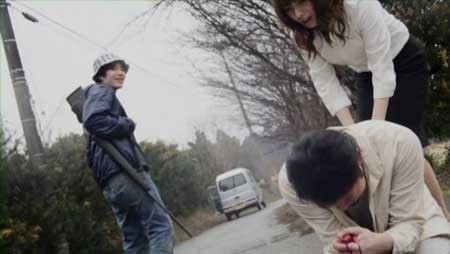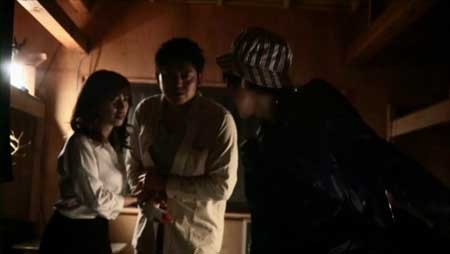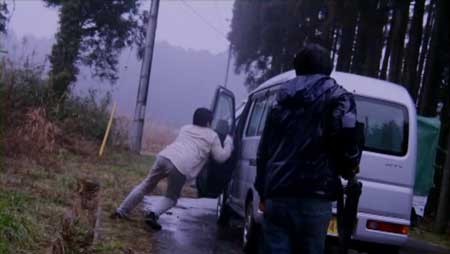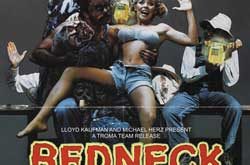SYNOPSIS:
The beautiful young Saeko and her abusive husband Yoshio are driving through the Japanese countryside. Yoshio continually makes things unpleasant for his unfortunate wife, fingering her while she’s driving and slapping her whenever his beer spills. They pick up a hitchhiker who, like Yoshio, is a fishing enthusiast. Things quickly turn sour, however, and the moment they find out that the hitcher has just robbed an armored car and killed two security guards, he already has a shotgun pointed in their direction. He makes it very clear that he will do anything to avoid capture, so Saeko and her husband are forced to submit to his cruel whims, hoping for the chance to escape.
REVIEW:
Hitch-Hike is one of a handful of recent low budget exploitation movies starring Japanese AV star Miyuki Yokoyama. The striking cover art of the Japanese DVD releases of these films invite comparison to the I Spit on Your Grave artwork of recent years – which is no coincidence, as the rape and revenge theme typifies Yokoyama’s rebirth in the horror genre.
English-language audiences are getting a taste of Yokoyama’s talents courtesy of Troma Entertainment’s release of two double features on DVD under the banner “From Asia with Lust”. The first volume pairs Hitch-Hike with the much superior Camp (2014), both directed by Ainosuke Shibata. Don’t let the Troma insignia/stigma (you decide which) fool you; Hitch-Hike is quite a change of pace for Kaufman and co. Agonizingly straight-faced and minimalist, there is little of the campy fun associated with the Troma touch.
Aside from a couple of neat twists, the film plays out with a minimum of plot across its scant 70 minutes. Saeko is bullied relentlessly by her prick of a husband, so within the opening moments we know we’re headed for an outcome that couples her own liberation with the husband’s comeuppance. As it’s a Japanese exploitation film, Saeko will need to be raped at some point, so that gives the hitcher something to do (but not before the husband screws her in front of a bunch of strangers). The problem with the young psychopath is that he simply doesn’t appear particularly threatening; he might shoot a few people and force himself on his female victims, but at no point does he achieve the kind of malevolent presence needed for this kind of role.
The movie’s most enjoyably over-the-top moment is when the hitcher strips off as he is about to rape Saeko, revealing his “custom-built brassiere” – a patchwork of nipples severed from previous victims, sewn directly onto his torso. His idea of getting Saeko in the mood is to assure her that he will be adding hers to the collection when they’re through. You can just imagine him teaming up with Leatherface, exchanging tips at a meeting of their weekly sewing circle.
Sadly, the bulk of the film is tepid and derivative. It strains against its budget all too noticeably, failing to deliver enough nudity or bloodshed to offset the humdrum mechanics of the narrative. Leading lady Yokoyama doesn’t have much to do but look gorgeous (which she does exceedingly well), as well as neglected and exploited (which, let’s face it, most Japanese actresses also do well). As the husband, Hiroaki Kawatsure kinda deserves to be tortured right from the start – unlike the wholly unfortunate character he played in torture P*rn classic Grotesque (2009).
Hitch-Hike is actually a loose remake of the Italian film of the same name from 1977, starring Franco Nero and David Hess. The original was bolstered by strong characterizations, whereas this Japanese imitation is strictly meat and potatoes when dealing with such dynamics, akin to something like the aforementioned Grotesque (which at least managed to deliver the goods in other areas, living up to its moniker). The Italian film also had a lot more bite, leading it to being censored or banned in some territories. This version, however, ends up as barely a ripple in the sea of sleaze. Where’s Rutger Hauer when you need him?
 Horror News | HNN Official Site | Horror Movies,Trailers, Reviews
Horror News | HNN Official Site | Horror Movies,Trailers, Reviews













